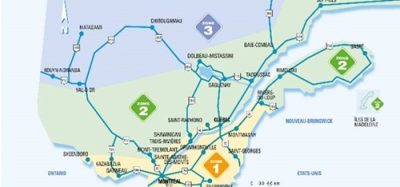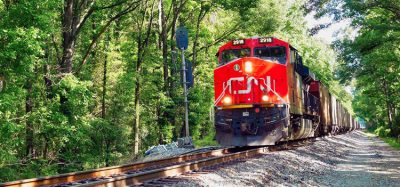Building on success: the liberalised and competitive Italian railway market
Posted: 1 August 2012 | | No comments yet
The European railway industry has radically changed over recent years following the introduction of high speed networks which have revolutionised society. Italy was the first country in Europe to launch the railway market liberalisation process by opening up to competitors. In just a few years, the economy of the sector was transformed, offering new economic and competitive opportunities to key operators. More recently, Italy opened up high-speed services to private competitors, despite the current economic crisis.
This was a historical change, one which Trenitalia prepared for with great care, working hard to address the situation and to offer its customers the best solutions.
The Freccia system (Frecciarossa, Frecciargento and Frecciabianco): The current competitive situation presents a strong challenge for improvement. Competition for Trenitalia is a positive factor for both customers and the market in general. In the high-speed sector, for example, the Frecciarossa fleet has recently been renewed with the introduction of four new service levels (L4) which have completely revolutionised the traditional two-class system. Comfort and customised services are now part of the winning formula. Travel safety, frequency and an articulated range of constant flexible and affordable prices must certainly not be underestimated.
The European railway industry has radically changed over recent years following the introduction of high speed networks which have revolutionised society. Italy was the first country in Europe to launch the railway market liberalisation process by opening up to competitors. In just a few years, the economy of the sector was transformed, offering new economic and competitive opportunities to key operators. More recently, Italy opened up high-speed services to private competitors, despite the current economic crisis. This was a historical change, one which Trenitalia prepared for with great care, working hard to address the situation and to offer its customers the best solutions. The Freccia system (Frecciarossa, Frecciargento and Frecciabianco): The current competitive situation presents a strong challenge for improvement. Competition for Trenitalia is a positive factor for both customers and the market in general. In the high-speed sector, for example, the Frecciarossa fleet has recently been renewed with the introduction of four new service levels (L4) which have completely revolutionised the traditional two-class system. Comfort and customised services are now part of the winning formula. Travel safety, frequency and an articulated range of constant flexible and affordable prices must certainly not be underestimated.
The European railway industry has radically changed over recent years following the introduction of high speed networks which have revolutionised society. Italy was the first country in Europe to launch the railway market liberalisation process by opening up to competitors. In just a few years, the economy of the sector was transformed, offering new economic and competitive opportunities to key operators. More recently, Italy opened up high-speed services to private competitors, despite the current economic crisis. This was a historical change, one which Trenitalia prepared for with great care, working hard to address the situation and to offer its customers the best solutions.
The Freccia system (Frecciarossa, Frecciargento and Frecciabianco)
The current competitive situation presents a strong challenge for improvement. Competition for Trenitalia is a positive factor for both customers and the market in general. In the high-speed sector, for example, the Frecciarossa fleet has recently been renewed with the introduction of four new service levels (L4) which have completely revolutionised the traditional two-class system. Comfort and customised services are now part of the winning formula. Travel safety, frequency and an articulated range of constant flexible and affordable prices must certainly not be underestimated. According to figures, since the inauguration of the Turin–Milan–Bologna–Florence–Rome– Naples–Salerno high-speed network in December 2009, the Freccia system has transported over 100 million passengers; 15 million of whom in just the first five months of 2012. Today, high-speed services are in great demand. They comprise 130 daily trains connecting the main cities up and down the peninsula, crossing the Apennines and over an area which – according to Unesco – contains half of the world’s artistic heritage and where 65% of the country’s work and mobility demand is concentrated. The Frecciarossa and Frecciargento services cover the country at approximately 300km/h. Routes include:
- Milan–Rome in 2 hours 55 minutes
- Milano Rogoredo–Roma Tiburtina in 2 hours 40 minutes (non-stop)
- Milan–Naples in 4 hours 15 minutes
- Milan–Florence in 1 hour 45 minutes.
The southeast and northeast of Italy also joined the high-speed system thanks to the growth in the use of the Frecciargento service, a multi-current and distributed traction tilting train, which can travel at speeds up to 280km/h, on mixed lines (high-speed and conventional), assuring fast links between Rome and Venice/Udine; Verona/Bolzano/Brescia; Bari/Lecce; Lamezia Terme/Reggio Calabria. The Frecciabianca service – which travels at 200km/h on the Trasversale Padana, Adriatica and Tirrenica Nord lines – has also grown as regards connections, quality and range of services. On 10 June 2012, the Frecciabianca service began to offer six new connections: four on the Adriatica line (Ancona–Milan, Lecce– Venice) and two on the Tirrenica Nord line (Genoa–Rome). Passengers on board the trains and at stations can now enjoy some benefits that were previously only available on the Frecciarossa and Frecciargento services.
Regional transport
Integration between high-speed transport and regional transport – which connects with the small urban centres – must also not be underestimated. In recent years, Trenitalia has launched local transport services in favour of commuters and Italian businesses, and begun a project to renew its fleet. Many Italian regions are now receiving the first new commuter trains that were comm – issioned at the end of 2009 in a tender worth €1,250 million and won by AnsaldoBreda. At the same time, a further investment of €1,250 million was made for more new trains, and the presentation deadline of offers for a further two tenders concerning the purchase of 130 electric and diesel trains, plus an option for another 60, for local and metropolitan transport, will soon be defined. More recently, the 350 new Vivalto carriages (under production in AnsaldoBreda workshops) started to be delivered to Tuscany, Lazio and Liguria in April 2012. Subsequently, 12/14 carriages a month will also be delivered to Friuli Venezia Giulia, Piedmont, Veneto and Lombardy. All of these regions had previously signed the Service Contract with Trenitalia in order to provide financial support for the expansion of regional trains. At the end of this modernisation process, at least 50 double-deck trains with E464 Bombardier traction units will have been added to the fleet. Each of these spacious trains can transport up to 850 people, all comfortably seated. Depending on the chosen layout of the train (ranging from five to seven coaches), the number of trains will vary from a minimum of 50 to a maximum of 66. The investment plan launched by Trenitalia in 2009, for the benefit of commuters, therefore continues and is consolidated, despite the fact that legislation has changed and that contracts stipulated with the regions now have a term of just six years. In fact, almost all of these expire in December 2014. The plan has already allowed 100 E464 traction units to be purchased on the basis of a supply contract signed with Bombardier in November 2009 for 150 locomotives. And, moreover, renovation and modernisation work on approximately 1,600 coaches has begun. Trenitalia’s commitment to provide services that are more and more suitable for the requirements of commuters is therefore producing concrete results which also involve the entire Italian railway sector and its ancillary industries. The new trains, double-deck coaches and traction units, are being fitted-out and the current fleet is being revamped by thousands of workers at 17 different factories, including eight Trenitalia facilities, located in 10 Italian regions. These improvements are objective and are borne out of the main indicators (punctuality and customer satisfaction), both at national level and in the various local areas. This is also demonstrated by the introduction, in agreement with the customer regions, of new offers, welcomed by commuters, and various best practices, especially in the cleaning sector, which are increasing the quality perceived by passengers. However, the current economic recession and the cuts made by the state in payments to the regions are creating enormous uncertainty for local transport for 2013. In 2013, if the regions will be unable to honour the Service Contracts – and there are already signs to that effect – it will be necessary to cut the services proportionally. A company cannot do anything else but this. Among other things, the unit regional transport revenues in Italy are much less, both than those of road transport and those in other European countries. In Italy, the regions and commuters pay Trenitalia an overall 10.8 cents per passenger-kilometre, while road transport collects 17.2 cents from the regions. In Germany, companies collect 20 cents for regional trains, 22 cents in France and from 19 to 35 cents in the UK.
Cargo
Trenitalia is the main promoter of the increased use of intermodal/multimodal transport for cargo in Italy, in favour of greater environmental sustainability. During the last 50 years, road transport has grown to the detriment of railways, in total contrast to the policy of the European Union which, for many years, has decided to focus on railways, which certainly have a lower environmental impact. The EU, in fact, aims to balance the modes (50% train and 50% road) by 2050. A transport policy in favour of sustainable modes must therefore be consolidated, both in Italy and in many other European countries. The only way out is to exploit rail-tyre intermodal synergies. Today, Italy’s transport system is on the verge of collapse, given that the main roads are saturated and that several road operators are carrying out a ‘dumping’ policy by asking the state for more and more subsidies to ensure their survival. Italy must truly organise its transport network according to a new logic in which co-modality, i.e. train and lorry, generates efficiency. It must therefore abandon its policy of subsidies in favour of incentives, not distributed at random, but targeted in favour of best multimodality practices in which trains cover medium-long distances and lorries the short ones; the so-called ‘last mile’. An example of best practice is the new multimodal service (mixed intermodal train) which guarantees a daily connection between Rivalta and Rome/Pomezia. This new service was implemented by Trenitalia Cargo thanks to the collaboration of Leroy Merlin Italia, Italia Logistica (Ferrovie Italiane and Poste groups) and Rivalta Terminal Europa. In 2011, intermodal transport on the Rivalta–Rome route saved 76% of energy and 72% of CO2 emissions1 compared with road transport. In Italy, intermodality must be supported through segregating transport by classes of distance and typology of cargo. Intermodal transport offers considerable environmental advantages, increases safety by reducing congestion in the motorway network, border crossings and ports with an impact on accident levels, energy saving and the relaunch of Italy as a European gateway, exploiting the geo – graphical position of Italy as a point of entry for goods bound for central Europe. Intermodal transport, the result of the synergy between rail and road, is the only way of balancing the two transport modes, given that also the liberalisation of the railway sector has not given the desired results. In fact, more than 10 years after RTC Cargo, the first private company in the sector in Italy, was established, we now have a good 35 qualified railway cargo companies (21 of which operative), incapable however of conquering market shares. In this scenario, Trenitalia Cargo is intensi – fying its efforts by implementing new higher quality services from and to the main Italian ports and interports and implementing new multi-customer services. These new multi-customer trains satisfy the need to offer the market a product which combines the typical crossing times and level of reliability of a complete train, with the flexibility of being able to ship small quantities of goods (a few wagons). In 2011, this policy led to positive results with approximately 6% more traffic, mainly international traffic, despite the recessive economic situation.
Internationalisation
It should not be forgotten that Trenitalia is part of a healthy and rapidly growing group – Gruppo Ferrovie dello Stato Italiane – which, despite the national and international economic crisis, has shown great vitality and capacity of renewal, closing 2011 with a significantly growing result and a net profit for the fourth consecutive year, amounting to €285 million. At the end of 2011 and for the first time, EBITDA of Gruppo FS, exceeded the threshold of €1.8 billion (EBITDA Margin at 21.8%), by approximately 8% compared with the €1,673 million at the end of the previous year. EBIT is growing strongly: €664 million, an increase of €157 million on 2010 (+31%). Also for Trenitalia, 2011 ended with strongly growing results compared with 2010. EBITDA reached €1,410 million (+11%) compared with the €1,270 million of 2010. EBIT touching on €500 million compared with the €342 million of 2010 (+45%). The group’s international vocation con – tinued to grow, thanks to its affiliates. In recent years, for example, Trenitalia has entered the European market as a railway operator in both the passenger and cargo sectors. As regards passenger transport, for example, it operates in France through TVT, the outcome of a partnership between Trenitalia and Veolia Transved. As regards cargo, instead, Trenitalia is present first and foremost with TX Logistic, its specialised goods transport company in North Europe and along the North–South corridor, across the Alps, and then in various countries with as many partnerships: in France with Trenitalia Logistic France, in Romania with Rom-Rail and in the Netherlands and Poland with Pol-Rail.
Safety
The need for mobility is always more present in contemporary society and the train is the easiest, safest and most eco-friendly way of satisfying this need. In previous years, Gruppo FS has invested €7 billion in safety technologies, an absolute priority for people and the environ – ment. Thanks to the integrated Quality, Environment, Occupational Health and Safety management system, Trenitalia – the only public transport company in Europe – has been certified by SGS (the Italian Management and Service Systems certification body). But one can never stop when it comes to safety issues. In the future another €2 billion will be spent, €600 million of which immediately, to con – solidate and improve the positive figures that already make Trenitalia one of the safest railway companies in the world.
The Frecciarossa 1000
From 19-25 August 2012, at the Meeting for Friendship among Peoples (held in Rimini), Trenitalia will give the world premiere of the new Frecciarossa 1000 – the train that will revolutionise the world of high-speed railways. Considered the new jewel of Trenitalia, Frecciarossa 1000 is a picture of technology, modernity and comfort, and will be available to be admired in its mock-up version (life-size with the same dimensions as the real train). The out – come of a partnership between AnsaldoBreda and Bombardier which won Trenitalia’s tender in August 2010, the new Frecciarossa 1000 can reach 400km/h and run at a commercial speed of 360km/h.
Reference
1. Source: EcoTransit
About the author
Vincenzo Soprano is an electrical engineer with extensive experience in national and international industrial groups including Agip (ENI Group) and Genese S.A. (Gaz de France). In 2001, Vincenzo joined Ferrovie dello Stato Italiane Group and, since September 2006, he has been Chief Executive Officer of Trenitalia SpA, the FS Group’s company responsible for passenger and cargo transport. Since May 2007, Vincenzo has also been President of FS Logistica SpA (FS Group’s cargo company) and, since August 2009, President of TRENORD Srl (managing company for local transportation in Lombardia Region). Since October 2011, Vincenzo has also been President of Netinera Deutschland GMBH (the FS Group’s transport company in Germany).







